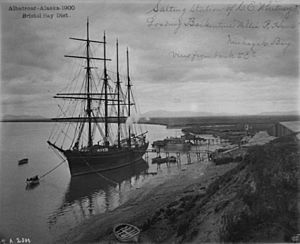Nushagak Bay facts for kids
Nushagak Bay is a very large estuary in southwest Alaska. An estuary is a place where a river meets the sea. This bay covers more than 100 square kilometers (about 38 square miles).
It connects to Bristol Bay, which is a big part of the Bering Sea. This area is north of the Alaska Peninsula. The biggest city nearby is Dillingham. Nushagak Bay is famous for having one of the world's best sockeye salmon fishing areas.
About Nushagak Bay
People living around Bristol Bay have always used the bay's resources. They use them for food for themselves and to make money. Even though the bay is very important, not many detailed science studies have been done there.
What Lives Here?
Scientists did a study in 2007 to see what kinds of animals live in Nushagak Bay. They found 16 different types of larger invertebrates. These included fish, isopods (small crustacean animals), amphipods (tiny shrimp-like creatures), and crangon shrimps.
Compared to other similar cold-water estuaries, Nushagak Bay has fewer types of animals. This is likely because the water in the bay has:
- Low salt levels
- Lots of cloudy water (high turbidity)
- Muddy sediments at the bottom
Protecting the Bay
Nushagak Bay is located downstream from a proposed mining project called the Pebble Mine. The mine's waste storage area would be built near the start of the Koktuli River. This river flows into the Nushagak River, which then flows into Nushagak Bay.
Many villages along the Nushagak River are strongly against this mine. They are worried about how it could affect the bay and its important salmon.
Where is it?
The bay mainly runs north to south. It stretches about 48 kilometers (30 miles) from the mouth of the Nushagak River to Bristol Bay. Other rivers also flow into Nushagak Bay. These include the Wood River, the Igushik River, and the Snake River.
See also
 In Spanish: Bahía Nushagak para niños
In Spanish: Bahía Nushagak para niños




